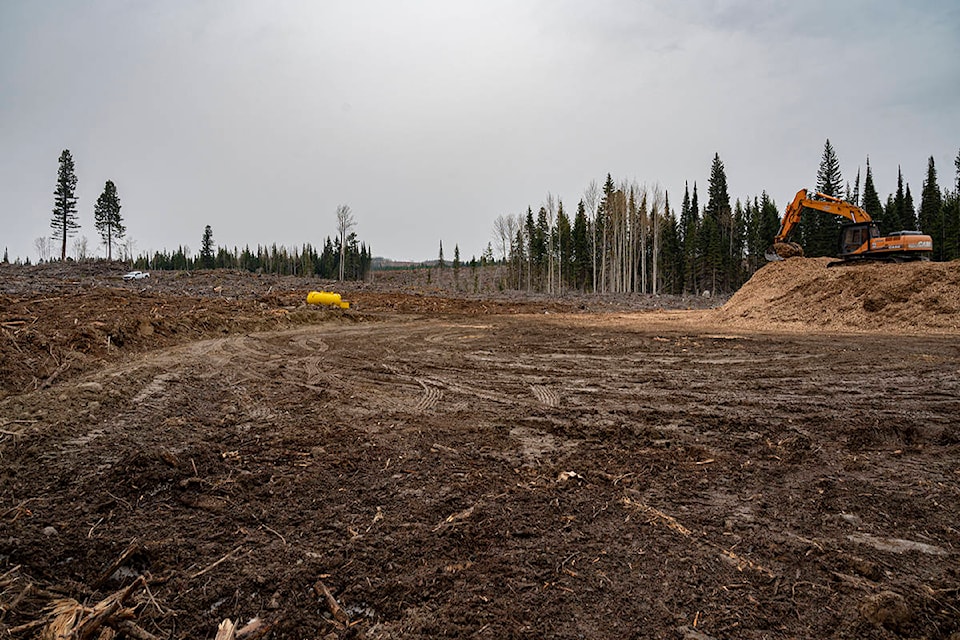The cumulative effects of logging, ranching, mining and urban development over decades have resulted in the degradation of the natural ecological integrity of the Okanagan’s forested watersheds.
The loss of natural ecosystem functioning has led to floods, erosion and drought.
In the Peachland watershed, there has been an overwhelming amount of degradation.
Industrial forestry has clearcut about 50 per cent of the forest watershed within the government’s designated “timber harvesting landbase.”
| Herb Hammond |
Clearcut logging remains the industrial forestry method of choice.
When clearcutting occurs in an intact mature forest, there is no canopy to intercept and relocate the snow.
Instead the snow that once evaporated and traveled to distant landscapes stays put, resulting in at least 30-40 per cent deeper snow packs in the clearcuts.
In the spring, snow in an exposed clearcut melts as much as 50 per cent faster than snow under the shade of a forest canopy.
This phenomenon results in flooding and erosion, and often leads to boil water advisories for downstream water users. Furthering the problem, too much water in the spring is followed by too little water in the fall, which results in droughts.
Not only has the winter snow pack in the clearcut landscape melted months ahead of schedule and diminished water in the soil to feed water courses, there are also not enough natural forest and wetlands left to capture and store water for the dry season.
In these ways, clearcut landscapes lead to spring floods and fall droughts.
The naturally dry Okanagan climate compounds the problems associated with clearcut logging.
As the climate emergency proceeds, the Okanagan will become even warmer and drier, exacerbating the negative effects of industrial forestry on water quality, quantity and timing of flow.
The ability for planted or naturally seeded trees to survive after clearcut logging is problematic, because clearcuts increase solar radiation reaching the ground, increase evaporation from the soil, and decrease soil water available for vegetation. In short, clearcuts contribute to a warmer and drier local climate.
Now with global heating, regenerating trees following clearcutting is becoming more difficult, and may lead to ecosystem shifts, where degraded shrub vegetation replaces diverse forest vegetation dominated by large trees that manage water.
Such a shift is most likely in dry environments, like the Okanagan watersheds.
As a case in point, the B.C. Forest Practices Board has recently published a report on the failure of Douglas-fir regeneration in clearcuts within dry interior forests.
This situation has been well known to many of us for decades, and now is finally getting some attention from the forestry establishment.
Industrial forestry exacerbates the climate emergency and biodiversity crisis, while forest professionals and timber companies assert that forestry is carried out in ways that best protect the public interest.
Two salient facts question this assertion: forestry is the leading cause of loss of biodiversity, and is the single largest greenhouse gas emitter in B.C. The situation in Okanagan watersheds today may begin to be reversed by the development and implementation of nature-based plans – also termed ecosystem-based conservation plans – for the drainage basins that contribute to the Greater Okanagan watershed.
These plans focus first on what to protect to conserve water, and then on what may be ecologically possible for human activities.
Nature-based watershed plans bring divergent interests together and promote a discussion about how to best protect water, while providing for ecologically and socially appropriate uses of the landscape.
It’s time to shift our thinking and understand that trees are not disposable parts of ecosystems.
We can’t clearcut and replant with the expectation that we can regrow a fully functioning, natural forest.
We can plant trees, but we cannot plant forests.
To prevent further floods, erosion, and droughts in Okanagan watersheds, the focus needs to be on protecting remaining intact forests and working with nature to restore forests degraded by industrial timber extraction.
Nature-based plans and community-based decision-making processes may determine that some limited logging is possible in some watersheds.
Where that occurs, clearcutting is prohibited and a fully functioning forest is left after logging.
A key part of continuous forest cover is to leave “full cycle” trees that constitute at least 30 per cent of the largest, healthiest trees well distributed across the logged area to safeguard the land and water.
Watershed-based plans rooted in Indigenous knowledge and appropriate western science provide a solid basis for change that is inclusive of most interests.
The exception is those interests that seek to profit at the expense of other humans, other beings, a moderate climate and water.
Keep in mind that healthy water from a forest watershed starts with drops that are captured and dispersed into the atmosphere, absorbed by plant bodies, and drip into the soil through their interception by large trees and multiple layers of forest vegetation.
Ecologically mature and old-growth forests do this best. Thus, to have clean, pure water in moderate flows we need to protect the forest structures that manage these drops.
Herb Hammond is a forest ecologist and forester in B.C. for more than 40 years. He has devoted the past several decades to developing and promoting nature-based plans which focus mostly on forests. He is the author of two books: Seeing The Forest Among The Trees: The Case For Wholistic Forest Use (winner of the Roderick Haig-Brown BC Book Prize) and Maintaining Whole Systems on Earth’s Crown: Ecosystem-based Conservation Planning for the Boreal Forest.
